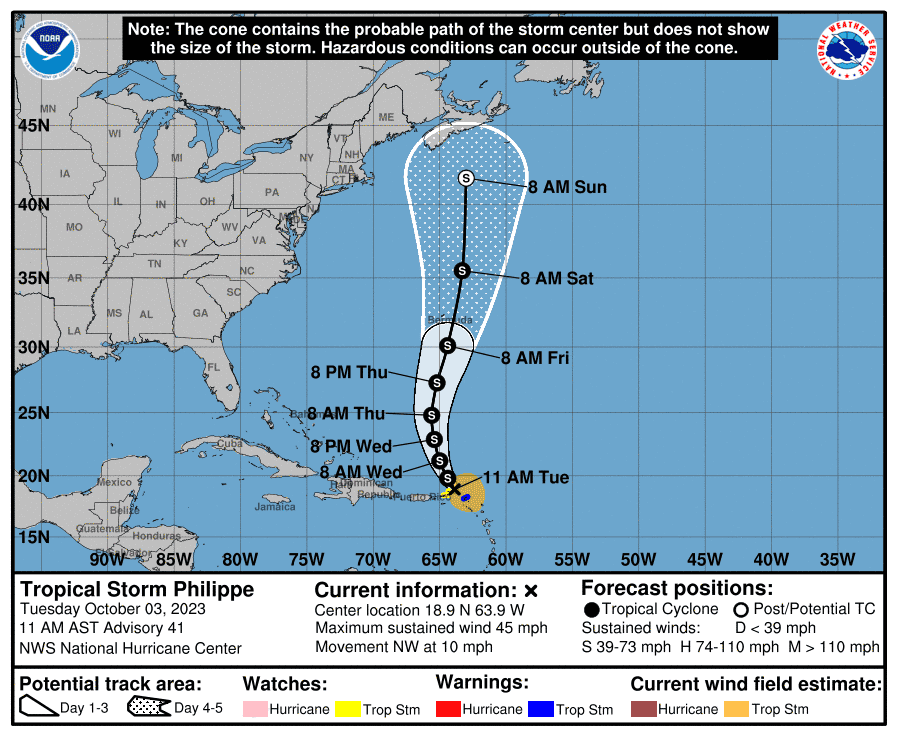Tropical Storm Philippe drenches Leeward Islands, likely headed for Atlantic Canada

Tropical Storm Philippe continued its long, slow trek across the Atlantic Ocean on Tuesday, as it brought heavy rain and high winds to the northern Leeward Islands, which are located in the northeastern Caribbean Sea. The storm forced governments to close schools in the region as forecasters warned of flash flooding.
Philippe is then forecast to spin north into the open Atlantic Ocean later this week, potentially sideswiping Bermuda before approaching Atlantic Canada over the weekend. It is not expected to strengthen into a hurricane as had been feared Monday.
Phillipe began its journey on Sept. 23 and ever since the storm as been slowly moving west, creeping closer to North America, AccuWeather said. Over the past few days, it outlasted its interaction with Tropical Storm Rina, which dissipated Sunday, the National Hurricane Center said.
Because of the ongoing tropical activity, the 2023 Atlantic hurricane season "has now officially met NOAA’s definition of an above-normal hurricane season," Colorado State University meteorologist Phil Klotzbach said Monday on X. So far, 18 named storms have formed, including a storm in January. A typical season sees 14 storms.
When storms collide: Tropical storms Philippe, Rina are colliding, creating the Fujiwhara Effect. What's that?
Where is Tropical Storm Philippe?
As of 5 p.m. EDT Tuesday, the center of Philippe was about 85 miles north of St. Thomas, which is one of the Virgin Islands. Top sustained winds were at 45 mph, and Philippe was moving northwest at 12 mph.
All tropical storm watches and warnings were cancelled in the Caribbean as Philippe began to pull away from the region. Still, up to a foot of rain was possible on Anguilla, Montserrat, St. Kitts and Nevis, and the British Virgin Islands, which could trigger flash flooding, the hurricane center said.
Officials in the twin-island nation of Antigua and Barbuda closed schools and government offices, while those in the French Caribbean territories of St. Martin and St. Barts closed schools.
Meanwhile, officials in Guadeloupe said the storm knocked power out to 2,500 customers and left several communities without running water. It also forced two road closures and left one community isolated as crews worked to reopen roads.
Gusty winds and rough, 'life-threatening' surf are possible
Gusty winds are likely to continue across portions of the northern Leeward Islands and the Virgin Islands through Wednesday, the hurricane center said.
The hurricane center also warned of dangerous surf conditions along the Atlantic coasts of the northern Leeward Islands, the Virgin Islands and Puerto Rico through midweek. "These swells are likely to cause life-threatening surf and rip current conditions," the hurricane center said.
Where is Tropical Storm Philippe headed? Could it hit Canada next week?
After impacting the Caribbean, the storm will travel for nearly 2,000 miles to the north over the next few days, where it could strike Atlantic Canada with heavy rain, strong winds and storm surge early next week, AccuWeather said.
Philippe is most likely to head toward Atlantic Canada, perhaps right into Nova Scotia late Sunday night or Monday, AccuWeather senior meteorologist Adam Douty said.
Special note on the NHC cone: The forecast track shows the most likely path of the center of the storm. It does not illustrate the full width of the storm or its impacts, and the center of the storm is likely to travel outside the cone up to 33% of the time.
Hurricane names: What are the hurricane names for the 2023 Atlantic season be named? Here's the list.
Tropical Storm Philippe spaghetti models
A note about the spaghetti models: Model plot illustrations include an array of forecast tools and models, and not all are created equal. The hurricane center uses the top four or five highest-performing models to help make its forecasts.
Contributing: The Associated Press
This article originally appeared on USA TODAY: Tropical Storm Philippe expected to move north; could it hit US?

